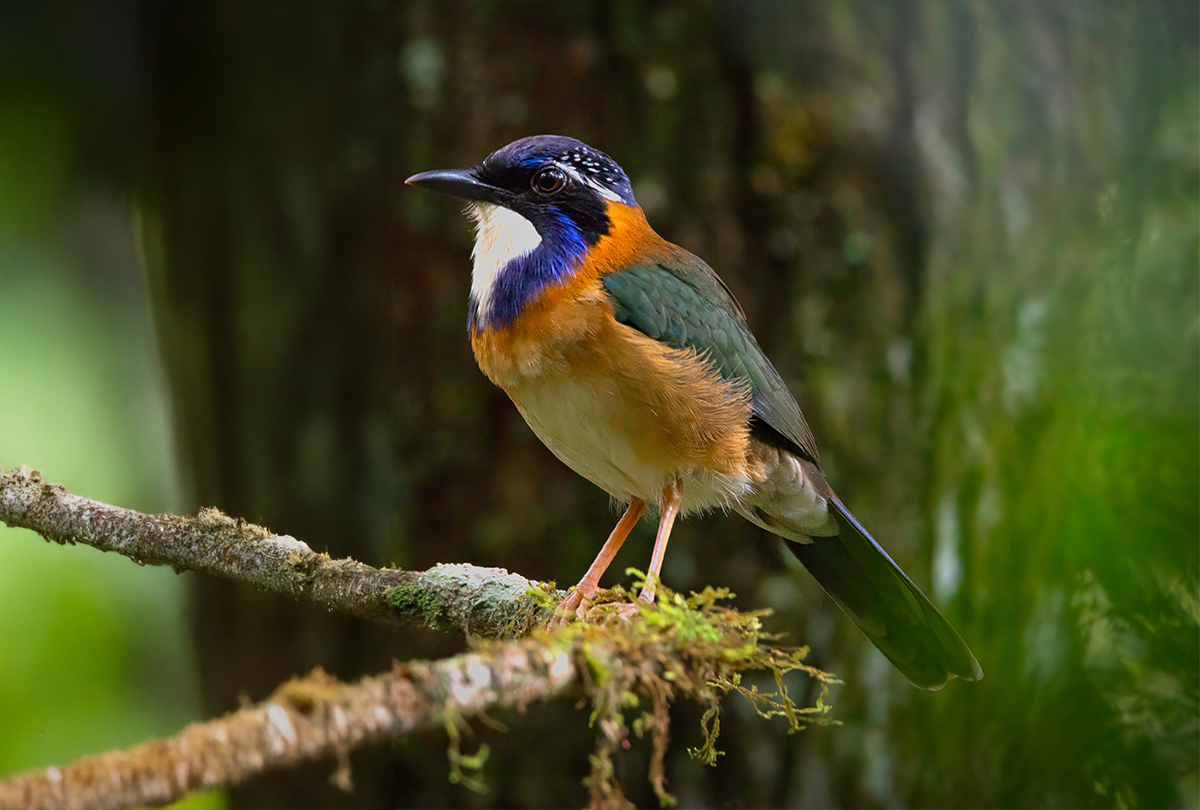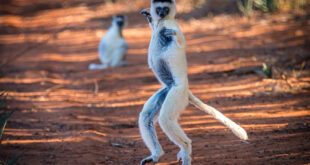Early in the morning, a deep, rather slowly repeated ‘bwup’ call can be heard in the rainforest. It is the call of the The pitta-like ground roller (Atelornis pittoides), a small bird that, like so many animals in Madagascar, is very special.
Pitta-like ground rollers are endemic to Madagascar
Pitta-like ground rollers are only found in Madagascar. They live in the rainforests of the east coast, from Montagne d’Ambre in the north to Midongy du Sud in the south-east. This means that they have the widest distribution of all ground rollers in Madagascar. Altitudes from sea level up to 2000 metres in the highlands are no problem. However, they are most common above 800 metres. This is probably also due to the fact that rainforests at higher altitudes are less threatened by deforestation and are often still untouched primary rainforests. This is because a good undergrowth layer with many different plants, which is particularly common in such forests, is the pitta-like ground roller’s favourite habitat.
This preference is closely linked to the terrestrial bird’s way of life: they spend a large part of their lives on the ground, running and hopping. They only flutter short distances in the low branches and hardly move out of the cover of the rainforest. Their hunting behaviour is characteristic: For a moment, the pitta-like ground roller stands motionless on the forest floor and observes its surroundings. Then it quickly dashes to another spot to observe the ground again. As soon as it spots prey, it dashes towards it. Incidentally, pitta-like ground roller are among the most popular subjects among birdwatchers in Madagascar – their way of life on the ground facilitates observation. They are also less shy than other raptors. Their splendid plumage does the rest.
By the way, there are no differences in appearance between the sexes. It is therefore very difficult to tell from the outside whether you are looking at a female or a male. The females of the species are only slightly larger and heavier. At a good 90 grams, they just reach the weight of a mandarin.

A partner and a nest for almost a lifetime
The diet of the pitta-like ground roller consists mainly of insects and arthropods of all kinds: ants, beetles, woodlice, cockroaches – the birds are not picky. During the rainy season in particular, however, you can also see them eat the odd frog or small chameleons. Various frog species reproduce explosively over several days at the beginning of the rainy season. Of course, the pitta-like ground roller also like to take advantage of so many prey animals in one go and help themselves to the abundant supply.
The breeding season for the pitta-like ground roller begins in the dry season at the end of October. Once males and females have found each other, they stay together for life. They occupy a common territory. Both partners build a sloping tunnel in the ground, which ends in a small nesting cavity. The entrance can be up to one metre long! The floor of the nesting cavity is gradually padded with soft plant material such as mosses and ferns. Finally, the female lays two to four shiny white eggs in the nest, which she incubates alone. Meanwhile, the male provides regular meals and brings in food. After hatching, both parents feed the young, as the offspring are extremely hungry!
Nesting often close to the edge of trails, they are are quickly disturbed
Pitta-like ground rollers prefer to build their nests in valleys, often along existing footpaths – in rainforests used by tourists also close to man-made circular trails. This makes the birds relatively susceptible to disturbance. However, due to its still large population numbers, the pitta-like ground roller is not considered endangered. But its habitat is threatened by deforestation and slash-and-burn agriculture all along the east coast of Madagascar. It is dependent on the forest and hardly ever occurs in destroyed or utilised landscapes. According to studies, even in much-frequented rainforests, the common vultures adapt to frequent disturbances – they lay fewer eggs or look for other nests further away from the paths. If a lot of people visit their nests, the pitta-like ground rollers have also been shown to call less than before. They are presumably trying to avoid potential predators that like to follow humans. These predators include the ring-tailed mongoose in particular – it is the most successful nest predator in this species.
On average, pitta-like ground rollers fledge after three to four weeks. The young should finally leave their nests in January at the latest, because with the cyclone season and the associated heavy rainfall, the chances of survival are no longer good.
For birdwatchers, November is the best time to travel to Madagascar. If you want to see pitta-like ground roller, you should go in search of them in the Andasibe-Mantadia or Ranomafana national parks. Many pairs of pitta-like ground rollers return to the same nest every year, so specialised guides know exactly where to find them. Good chances if you have the right guide!
-
- Biodiversity and Ecotourism: Impacts of habitat disturbance on an endangered bird species in Madagascar
Biodiversity, 4:4, 9-16, | USA 2011 | Autor: Jean Claude Razafimahaimodison - Fotos von Frans Lanting
- Rufe, Videos und Verbreitungskarten auf eBird
- Biodiversity and Ecotourism: Impacts of habitat disturbance on an endangered bird species in Madagascar
 MADAMAGAZINE Your Magazine about Madagascar
MADAMAGAZINE Your Magazine about Madagascar




